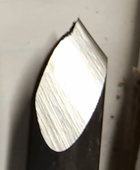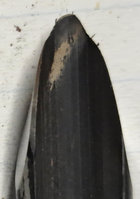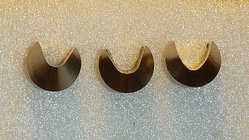-
It's time to cast your vote in the October 2025 Turning Challenge. (click here for details) -
Congratulations to Curt Fuller for "Bell Ornaments" being selected as Turning of the Week for October 27, 2025 (click here for details) -
Welcome new registering member. Your username must be your real First and Last name (for example: John Doe). "Screen names" and "handles" are not allowed and your registration will be deleted if you don't use your real name. Also, do not use all caps nor all lower case.
You are using an out of date browser. It may not display this or other websites correctly.
You should upgrade or use an alternative browser.
You should upgrade or use an alternative browser.
Gouge Grinding Problem
- Thread starter Bob East
- Start date
Could the wheel be something other than true?
- Joined
- Apr 27, 2004
- Messages
- 9,293
- Likes
- 6,041
- Location
- Lakeland, Florida
- Website
- www.hockenberywoodturning.com
L
With experience they will look the same.
The right side of that tool is unusable.
I see 2 potential problems. Without being there these are best guesses from having corrected grinds on hundreds of student tools
1.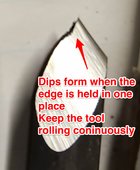
If you stop the edge on the wheel at one spot it grinds a dip.
I teach my students to grind each wing twice avoiding the tip
Then grind once across the tip. This avoids overgrinding the tip.
Had to go from wing edge to wing edge until you get lots of practice
2.
The left side has a wide spot where you haven’t ground to the flute.
The wire like steel threads indicate the edge is too thin and bending rather than forming a sharp edge with the flute
When I get a new gouge I turn it upside down on a platform with top of flute square on the platform I shape the curve on the top of the wing and nose grinding a small flat. This is jointing the edge.
Then use the jig to grind the flat away for in an edge with the flute.
Also if you haven’t already done so check out the hand on club. They meet in Beverly Hills
As I sharpen I watch the edge. When I see sparks breaking on the flute I know I have sharpened that part.
Be sure to surface your grind wheel.
Having the wing slightly uneven is not a big problem. You only turn with one side at a time.what's causing this?
With experience they will look the same.
The right side of that tool is unusable.
I see 2 potential problems. Without being there these are best guesses from having corrected grinds on hundreds of student tools
1.

If you stop the edge on the wheel at one spot it grinds a dip.
I teach my students to grind each wing twice avoiding the tip
Then grind once across the tip. This avoids overgrinding the tip.
Had to go from wing edge to wing edge until you get lots of practice
2.

The left side has a wide spot where you haven’t ground to the flute.
The wire like steel threads indicate the edge is too thin and bending rather than forming a sharp edge with the flute
When I get a new gouge I turn it upside down on a platform with top of flute square on the platform I shape the curve on the top of the wing and nose grinding a small flat. This is jointing the edge.
Then use the jig to grind the flat away for in an edge with the flute.
Also if you haven’t already done so check out the hand on club. They meet in Beverly Hills
As I sharpen I watch the edge. When I see sparks breaking on the flute I know I have sharpened that part.
Be sure to surface your grind wheel.
Last edited:
Can I restore that right side by jointing the top edge & then regrinding the wings?L
Having the wing slightly uneven is not a big problem. You only turn with one side at a time.
With experience they will look the same.
The right side of that tool is unusable.
I see 2 potential problems. Without being there these are best guesses from having corrected grinds on hundreds of student tools
1.View attachment 46449
If you stop the edge on the wheel at one spot it grinds a dip.
I teach my students to grind each wing twice avoiding the tip
Then grind once across the tip. This avoids overgrinding the tip.
Had to go from wing edge to wing edge until you get lots of practice
2.View attachment 46450
The left side has a wide spot where you haven’t ground to the flute.
The wire like steel threads indicate the edge is too thin and bending rather than forming a sharp edge with the flute
When I get a new gouge I turn it upside down on a platform with top of flute square on the platform I shape the curve on the top of the wing and nose grinding a small flat. This is jointing the edge.
Then use the jig to grind the flat away for in an edge with the flute.
The left side appears thick as I did try to reshape the curve of the wings.
Thanks!
I use a 320 grit cbn wheel about a yr old on a new Rikon grinder so. It doesn't appear to out of round.Could the wheel be something other than true?
- Joined
- Apr 27, 2004
- Messages
- 9,293
- Likes
- 6,041
- Location
- Lakeland, Florida
- Website
- www.hockenberywoodturning.com
You can get a grind to match the set up of the varigrind, protrusion, and pocket position.Can I restore that right side by jointing the top edge & then regrinding the wings?
The left side appears thick as I did try to reshape the curve of the wings.
Thanks!
When I joint the tops of the wings I want a visible flat. The narrower the flat the less tool steel to grind away
A 320 wheel will be slow going so be patient stop a rest if it feels tedious.
Stop frequently and look at the thickness of the jointed flat. Grind the thicker parts more.
When you see sparks breaking on the flute edge don’t grind that part any more.
Once you have the whole edge close or with sparks breaking then you can reset the protrusion and re grind the tool lightly to blend it all together.
Then every you sharped just look for sparks breaking on the edge.
Don’t over sharpen and keep the edge rolling when in contact with the wheel.
I tend to get those dips, still, even though I've been using the Wolverine system for 10 years or more. As mentioned, you need to spend less time on the portion of the edge where the dip occurs, AND/OR you need to apply less pressure when passing over that area.
In my case, I believe my problem is that I leave my Thompson gouges in their handles when I grind. That means there is a long, heavy lever opposite the wheel and I have to stand to the side in order to sharpen. In doing so, there is inherently a moment during the rolling process where I'm in the way and there's a hesitation. It's also likely that I'm pressing a little harder as I transition from one hand/body position to the other.
So, don't forget that you might unintentionally be pressing a little harder momentarily during the rolling of the tool and take a look at your body mechanics and the movement of the tool in the jig as you try to figure out the why of things.
In my case, I believe my problem is that I leave my Thompson gouges in their handles when I grind. That means there is a long, heavy lever opposite the wheel and I have to stand to the side in order to sharpen. In doing so, there is inherently a moment during the rolling process where I'm in the way and there's a hesitation. It's also likely that I'm pressing a little harder as I transition from one hand/body position to the other.
So, don't forget that you might unintentionally be pressing a little harder momentarily during the rolling of the tool and take a look at your body mechanics and the movement of the tool in the jig as you try to figure out the why of things.
If you start flat on the left side of the tool and swing all the way through the nose (to the right side of the nose) and then repeat from the right side of the tool all the way through the nose (to the left side of the nose) you should accomplish 2 things, no dip and a less pointy tool. 95% of the tools I use are Thompsons so I take them out of the handle which makes them so much easier to sharpen. For my gouges I use the Vector Grind Fixture which by its make up you use the left to right and right to left swing (no dips).
It took me a long time to get predictable using the wolverine jig. Not as idiot proof ( speaking to myself here, not you) as it appears. As I heard someone say - all it does it set the angle, the shape and edge are your responsibility. I use a blue sharpie along the edge EVERY time I sharpen a tool. If you don't it may look shiny and sharp but not quite there. You may still see a blue streak across the edge in some places, usually on just one side. All it takes is a little difference in your hand pressure or grip to cause a difference in the sides. Sharpening without the handle helped me a great deal in terms of consistency. Now I seldom see a little blue sharpie line left but I still use it every time.
You should spend just a tad bit longer on the nose, and then blend the sides into it. It's a very common mistake you are making there. I teach turners to consider the bowl gouge as 3 surfaces to grind and then blend together.
Also, be very careful with varigrind-1 to make sure the tool doesn’t slide off the wheel. The Varigrind-2 is designed to prevent tools from slipping off the wheel. Many people dislike the varigrind-2 design because of the lack of freedom to grind across the entire wheel, but many don’t realize the tool holder can be used without the base part. I can stick my varigrind-2 tool holder in the v-arm like a varigrind-1. Not suggesting you need to switch though. Just need to be a more careful with varigrind-1 Is all.
Lots of good suggestions. IMO what will help the most is a removable handle. It makes the tool/jig so much easier to handle. There are many alternatives for handles. I just make my own and use inserts from Cindy Drozda - 2 set screws hold the tool.
As others said, its the amount of time and pressure at any point along the bevel. Its really no different than tool control while cutting - keep working at it and things will eventually fall into place. One day you will look back and wonder why it was such a struggle - we’ve all been there and occassionally return
As others said, its the amount of time and pressure at any point along the bevel. Its really no different than tool control while cutting - keep working at it and things will eventually fall into place. One day you will look back and wonder why it was such a struggle - we’ve all been there and occassionally return
What flute profile does the gouge have? Is it U, V or Parabolic? U flutes are more prone to 'beaking' with a swept back side grind. To quote David Ellsworth...
"The most important design change for
the side-grind gouge has been the shape
of the flute. All the traditional gouges in
the 1980s had a flute shape that had two
straight side walls that intersected the
radius curve at the bottom of the flute.
They all worked fine for their respective
purposes because these gouges were
designed to cut wood at the end of the
tool, not the side. But when converting
these tools to the side-grind design, the
intersection of the straight side walls
with the curve at the bottom of the flute
created a slight dip in the edge on both
sides and immediately back from the tip
of the tool" David Ellsworth pg 18
December 2019 AAW Journal
I had the Varigrind-2 and found it to be kinda loose and didn't trust it with my students. I opted for the S900 Sharp Fast System which although similar to the Varigring-2 it is much tighter in use as I believe it uses brass bearings to hold a tighter arc when sharpening so absolutely keeping the tool in the middle of the wheel (no accidental falling of the wheel accidents). Best used with CBN as always grinding with it on a stone wheel will leave a rut after a few sharpenings.Also, be very careful with varigrind-1 to make sure the tool doesn’t slide off the wheel. The Varigrind-2 is designed to prevent tools from slipping off the wheel. Many people dislike the varigrind-2 design because of the lack of freedom to grind across the entire wheel, but many don’t realize the tool holder can be used without the base part. I can stick my varigrind-2 tool holder in the v-arm like a varigrind-1. Not suggesting you need to switch though. Just need to be a more careful with varigrind-1 Is all.
I find the little bit of slack allows me to use a little more of my CBN wheel. If looseness is a concern then it would be easy enough for someone to add some tape or small vinyl tube (sliced longways) on the base to take up any slack. The Sharp Fast is an expensive fix, but any excuse to buy a new jig is OK in my book because it gives us extra stuff to pass along to other turners. Hopefully your VG2 isn’t sitting in a drawer never to see the light of day. If so then let me know what you want for it?I had the Varigrind-2 and found it to be kinda loose and didn't trust it with my students. I opted for the S900 Sharp Fast System which although similar to the Varigring-2 it is much tighter in use as I believe it uses brass bearings to hold a tighter arc when sharpening so absolutely keeping the tool in the middle of the wheel (no accidental falling of the wheel accidents). Best used with CBN as always grinding with it on a stone wheel will leave a rut after a few sharpenings.
I always recommend Doug Thompson's video on grinding bowl gouges for anyone who is having problems with their grinds... see the section between 9min to 18min ...
View: https://youtu.be/ttYyulsM7wg?t=541
Note: the bowl gouge Doug is grinding has a V flute profile (as seen looking directly end-on to his flute), not parabolic, as Doug says... it can't be both V and parabolic...
A bowl gouge V flute profile has straight sides and a circular curve at the bottom that forms a tangent with the straight sides. In the following photo Doug's BG on the left and the Jamieson designed BG (made by Doug) are both V flutes, while the Henry Taylor superflute on the right is parabolic. Parabolic flutes don't have any straight sided sections. All very nice gouges, BTW, but with different flute profiles that shouldn't be confused.
Note: the bowl gouge Doug is grinding has a V flute profile (as seen looking directly end-on to his flute), not parabolic, as Doug says... it can't be both V and parabolic...
A bowl gouge V flute profile has straight sides and a circular curve at the bottom that forms a tangent with the straight sides. In the following photo Doug's BG on the left and the Jamieson designed BG (made by Doug) are both V flutes, while the Henry Taylor superflute on the right is parabolic. Parabolic flutes don't have any straight sided sections. All very nice gouges, BTW, but with different flute profiles that shouldn't be confused.
I'm surprised John Lucas hasn't mentioned that he has an excellent video on gouge grinding problems and how to fix them. It's on youtube here:
View: https://www.youtube.com/watch?v=M9G16ylEZHQ
I tell my students, if you can't stay on a 1" wheel, you have your eyes closed .Also, be very careful with varigrind-1 to make sure the tool doesn’t slide off the wheel. The Varigrind-2 is designed to prevent tools from slipping off the wheel. Many people dislike the varigrind-2 design because of the lack of freedom to grind across the entire wheel, but many don’t realize the tool holder can be used without the base part. I can stick my varigrind-2 tool holder in the v-arm like a varigrind-1. Not suggesting you need to switch though. Just need to be a more careful with varigrind-1 Is all.
Karl no it was sold a while back. Not worried about using more of the CBN wheel as it is CBN and is not going to wear out with student use.I find the little bit of slack allows me to use a little more of my CBN wheel. If looseness is a concern then it would be easy enough for someone to add some tape or small vinyl tube (sliced longways) on the base to take up any slack. The Sharp Fast is an expensive fix, but any excuse to buy a new jig is OK in my book because it gives us extra stuff to pass along to other turners. Hopefully your VG2 isn’t sitting in a drawer never to see the light of day. If so then let me know what you want for it?
Last edited:
I have had 2 non students who have been turning for a year or three during a hands on with a pro slide off the stone wheel and take a big chunk out of the wheel. Thankfully no one was hurt. I show my students how to sharpen with the Vector Grind Fixture, the Qneway sharpening system and the Woodcut sharpening system but as long as they are my students they use the Sharp Fast in house.I tell my students, if you can't stay on a 1" wheel, you have your eyes closed .
John Jordan
In Memorium
- Joined
- Jun 24, 2008
- Messages
- 506
- Likes
- 976
- Location
- Cane Ridge (Nashville), TN
- Website
- www.johnjordanwoodturning.com
You're lingering too long in that spot. It's also possible that the flute is not shaped properly-not unheard of. The fix is the same, pay attention and don't grind the low areas. It appears that the geometry of the setup is good, you don't need to change anything-just lighten up your touch and avoid the low spots until it's back to even.
John
John
Odie
Panning for Montana gold, with Betsy, the mule!
JJ's solution above this post works.
Another possibility is the tip could be "rounded" a little bit more and blended into where the dip first starts on the wing.
Even though I'm one who prefers a traditional grind instead of the more popular swept-back grinds of today.....the solutions to a dip in the grind, as shown in the OP's photo, are the same.
-----odie-----
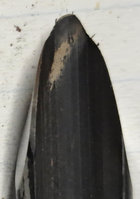
Another possibility is the tip could be "rounded" a little bit more and blended into where the dip first starts on the wing.
Even though I'm one who prefers a traditional grind instead of the more popular swept-back grinds of today.....the solutions to a dip in the grind, as shown in the OP's photo, are the same.
-----odie-----

I have a Carter and sons 5/8ths bowl gouge with a u-shape flute. It’s a bear to sharpen without the two dips as the OP. The issue, as best I can observe, is that there are two processes in making the flute. The bottom is round. Then there are the two straight cuts, from the top of the flute to the round section. That intersection is the problem. Not quite tangent.
I get mine the best I can, and don’t fret about it too much. Gouge works great.
I get mine the best I can, and don’t fret about it too much. Gouge works great.
john lucas
AAW Forum Expert
terrier. Favorite tool is the Thompson V. If you look close you can see the change in the flute shape from the bottom to the side. This is where the little dip in the edge comes from if your not careful how you grind.

